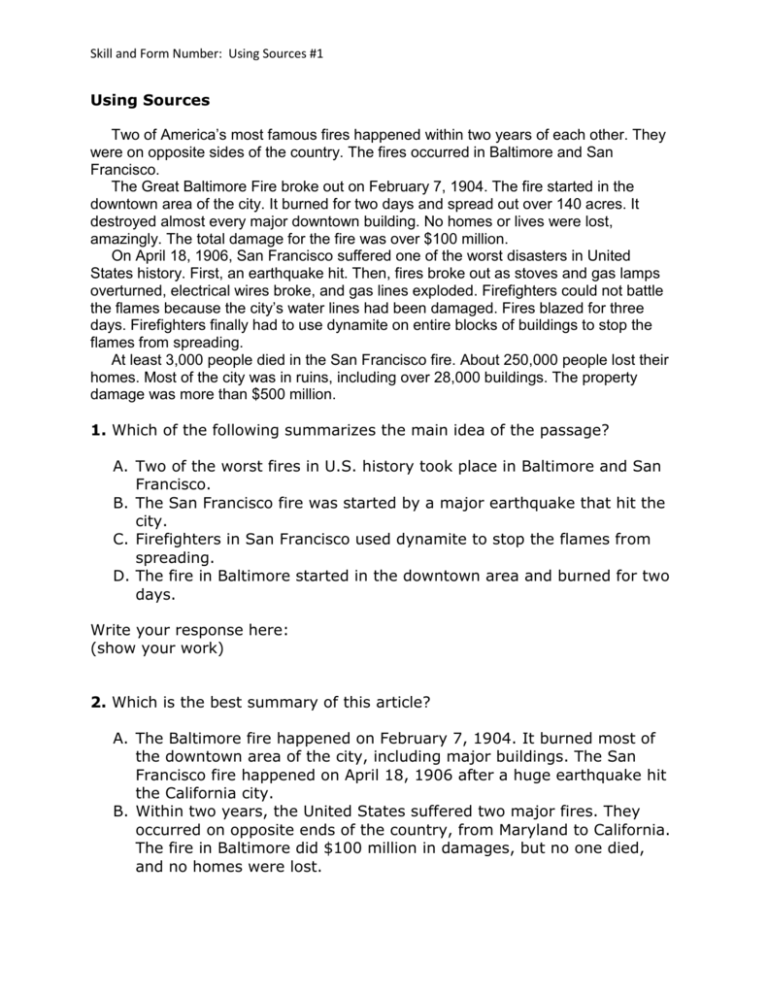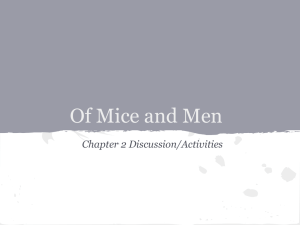
Skill and Form Number: Using Sources #1
Using Sources
Two of America’s most famous fires happened within two years of each other. They
were on opposite sides of the country. The fires occurred in Baltimore and San
Francisco.
The Great Baltimore Fire broke out on February 7, 1904. The fire started in the
downtown area of the city. It burned for two days and spread out over 140 acres. It
destroyed almost every major downtown building. No homes or lives were lost,
amazingly. The total damage for the fire was over $100 million.
On April 18, 1906, San Francisco suffered one of the worst disasters in United
States history. First, an earthquake hit. Then, fires broke out as stoves and gas lamps
overturned, electrical wires broke, and gas lines exploded. Firefighters could not battle
the flames because the city’s water lines had been damaged. Fires blazed for three
days. Firefighters finally had to use dynamite on entire blocks of buildings to stop the
flames from spreading.
At least 3,000 people died in the San Francisco fire. About 250,000 people lost their
homes. Most of the city was in ruins, including over 28,000 buildings. The property
damage was more than $500 million.
1. Which of the following summarizes the main idea of the passage?
A. Two of the worst fires in U.S. history took place in Baltimore and San
Francisco.
B. The San Francisco fire was started by a major earthquake that hit the
city.
C. Firefighters in San Francisco used dynamite to stop the flames from
spreading.
D. The fire in Baltimore started in the downtown area and burned for two
days.
Write your response here:
(show your work)
2. Which is the best summary of this article?
A. The Baltimore fire happened on February 7, 1904. It burned most of
the downtown area of the city, including major buildings. The San
Francisco fire happened on April 18, 1906 after a huge earthquake hit
the California city.
B. Within two years, the United States suffered two major fires. They
occurred on opposite ends of the country, from Maryland to California.
The fire in Baltimore did $100 million in damages, but no one died,
and no homes were lost.
Skill and Form Number: Using Sources #1
C. America has had many famous fires in its history, from Baltimore to
San Francisco. The great fire in San Francisco was started by an
earthquake. Firefighters had to use dynamite to level entire city blocks
to stop the spreading flames.
D. The Baltimore fire and the San Francisco fire happened within two
years of each other. Both fires ruined many buildings and cost over
$100 million in damages, but the San Francisco fire was far worse than
the Baltimore fire.
Write your response here:
(show your work)
Author Sandra Cisneros was born in Chicago, Illinois. When she was growing up,
her parents encouraged her to get a good education. Her mother made sure that she
and her brothers had access to educational material. Her father always stressed the fact
that it was important for them to study hard. She began writing poetry in high school.
She went on to earn a master's degree in English in 1976. Cisneros continued writing
poetry and stories after she graduated from college. A book of her poetry titled Bad
Boys was published in 1980. She published her most popular book, The House on
Mango Street, in 1984. She based many of the stories in The House on Mango Street
on her own experiences. Since 1984, The House on Mango Street has sold more than
two-million copies. Cisneros currently lives in San Antonio, Texas.
3. Which detail is important and should be included in the summary of this
passage?
A.
B.
C.
D.
The House on Mango Street is Cisneros' best book.
Cisneros began writing when she was in college.
Cisneros received her master's degree in 1976.
Bad Boys, a book of poetry, was published in 1984.
Write your response here:
(show your work)
There is a lot of research that needs to be done before you buy a used car. Think
about things like what you will be using it for, how much you can afford to spend, and
why you need the car. How many miles do you drive a day? Is there anything you have
to have in a car like an iPod connection or power locks and windows? Do you need to fit
a lot of people in the car?
Research the maintenance fees and reliability ratings associated with the car models
you’re interested in. Read newspaper classifieds to find cars for sale in your area. The
Internet is a valuable source of information about buying a car. The local library is also a
good place to start your search. You can find some informative books about purchasing
a car there.
Skill and Form Number: Using Sources #1
4. Which source would add the most relevant and appropriate information to
the essay above?
A.
B.
C.
D.
a police report of the type of car stolen most often last year
a police report detailing drag-racing accidents
testimony from a car manufacturer's Web site
a television advertisement for a new car insurance company
Write your response here:
(show your work)
Passage 1
What is The Freshman Fifteen?
The term "freshman fifteen" is used to describe the weight gained by students during
their freshman year of study in college or university. It is said that freshmen typically
gain fifteen pounds during their first year. "Freshman fifteen" is an often-reported, but
unproven claim in the U.S. and Canada.
The weight gain is chiefly because of cafeteria-style food that is rich in fat and
carbohydrates. University dorms also serve the students a lot of fast food. Many dining
halls in U.S. universities are all-you-can-eat style. These cafeterias also have plentiful
dessert options.
In addition to food, students gain weight because of lack of sleep. Lack of sleep may
cause overeating and weight gain because it lowers the level of leptin. Leptin is a
protein produced by fat cells. Leptin regulates food intake and fat storage in the body.
It is common in U.S. universities to have staff dieticians on campus. These staff
dieticians often put up posters to encourage healthy eating. Many seminars are held on
campus to teach about eating and nutrition. These seminars also provide tips on how to
avoid weight gain.
Students may also skip meals and experience more stress in college. Stress and
unbalanced eating may also cause weight loss. The change in lifestyle and a sudden
change in weight also cause poor nutrition and eating disorders. Poor nutrition and
eating disorders are more common among female students.
When University of Guelph professors Alison Duncan and Janis Randall Simpson
conducted a study of first-year female students, they found that female students were
likely to gain only five pounds, and not fifteen. Duncan and Simpson have since begun a
study to see if the weight-gain pattern is the same for first-year male students.
Researchers disagree that the term "freshman fifteen" reflects the actual number of
pounds gained by freshmen. Some evidence suggests that this term used to be
"freshman ten." The "freshman 10" has become the "freshman 15" because the weight
of the average person has increased. Students are gaining more weight than they did a
few decades ago.
Passage 2
Skill and Form Number: Using Sources #1
Beating the 'Freshman 15'
People talk about the "freshman 15." Do some college students really gain 15
pounds in their first year? Researchers at Cornell University found that students gained
an average of 4 pounds during their first 12 weeks of their freshman year. The rate of
gain is 11 times higher than the typical weight gain for 17 and 18 year-olds. Not
everyone will gain the full 15, though. A study by researchers at Tufts University found
that men gain 6 pounds and women gain 4.5 during their first year at college.
What's Behind First-Year Weight Gain?
College offers many temptations. You are free to eat what you want, when you want.
You can get more portions in the dining hall and eat unhealthy snacks to help with latenight studying. You may not get as much exercise as you did in high school. College is
also a time of change. Getting used to a new school can cause people to overeat.
Sometimes people eat because of anxiety, homesickness, sadness, or stress.
Should I Worry About the Weight?
Some weight gain is normal as a body grows and metabolism changes. Rapid weight
gain may become a problem. Weight gain that pushes above your body's normal range
has health risks. People who are overweight are more likely to have high blood pressure
and cholesterol, trouble breathing, and joint problems. Overweight youths are more
likely to become overweight adults. Poor diet and exercise habits in college can put you
on a path to heart disease, type 2 diabetes, or obesity and may increase your risk for
certain cancers.
Unhealthy food choices won't give you the nutrients you need to keep up with the
strain of college. Your energy will drain, and your concentration and memory will suffer.
The Tufts study found that almost 70% of students get fewer than the recommended
five servings of fruits and vegetables each day.
How Can I Avoid Gaining Weight?
Avoid eating when you are stressed, studying, or watching TV. Here are some steps
to start a healthy food attitude:
eat slowly
eat at regular times
limit between-meal snacking
choose nutritious foods
pick lower-fat foods when possible (milk and salad dressing)
watch the size of portions (not too much or too little)
avoid vending machines and fast food
keep healthy snacks in your room
replace soft drinks with water and healthier beverages
Smoking is another problem. Cigarettes may slow your appetite, but they can make
exercise and normal activity more difficult. Smoking also causes heart and lung
problems and increases your risk of cancer. Get enough exercise and sleep. Those who
Skill and Form Number: Using Sources #1
exercise at least three times a week are more likely to be in better health and have
greater happiness than those who do not exercise. They also tend to use their time
doing something productive. Gaining weight during the first year of college doesn't have
to happen. You may have your ups and downs. A few simple changes to your daily
routine can keep you healthy.
This information was provided by KidsHealth, one of the largest resources online for medically reviewed
health information written for parents, kids, and teens. For more articles like this one, visit
www.KidsHealth.org or www.TeensHealth.org.
©1995-2007. The Nemours Foundation
5. How is the information in the first passage similar to the information in
the second passage?
A.
B.
C.
D.
Both
Both
Both
Both
passages
passages
passages
passages
discuss the reasons behind the freshman fifteen.
discuss eating disorders found in female students.
inform the reader about term the "freshman ten."
warn the readers against the dangers of smoking.
Write your response here:
(show your work)
6. In what way is the information in the first passage different from the
information in the second passage?
A. The first passage mentions eating disorders while the second passage
mentions mood disorders.
B. The second passage mentions research-based facts about freshman
fifteen; the first passage does not.
C. The first passage suggests freshman fifteen happens to everyone; the
second passage does not.
D. The second passage explains more ways of avoiding freshman fifteen
compared to the first passage.
Write your response here:
(show your work)
7. What cause of weight gain is mentioned in the second passage but not in
the first passage?
A.
B.
C.
D.
fast food in college dorms
plentiful dessert options
a lack of exercise in college
the stress of college life
Skill and Form Number: Using Sources #1
Write your response here:
(show your work)
8. How does the information in the first passage differ from the information
in the second passage?
A. The first passage mentions that everyone gains freshman fifteen; the
second passage says that only male students will gain weight.
B. The first passage is written by someone who has suffered from the
freshman fifteen; the second passage is written by professionals.
C. The information in the first passage is only written for the USA and
Canada; the second passage is for college students around the world.
D. The information in the first passage cites one research study; the
information in the second passage cites more research studies.
Write your response here:
(show your work)
9. Using information from both passages, what conclusion can be drawn
about gaining extra weight during the freshman year?
A.
B.
C.
D.
Male and female college students equally gain weight during college.
College students lose weight the more they eat cafeteria food.
Only males can avoid extra weight gain during the freshman year.
Extra weight gain can be avoided during the freshman year.
Write your response here:
(show your work)
Passage 1
Talking about Spices
A spice is a dried seed, fruit, root, bark, or vegetative substance used in small
quantities. A spice is used as a food additive for flavoring. Sometimes a spice is used as
a preservative. Spice kills or prevents the growth of harmful bacteria. Many spices are
also used for medicine, religious rituals, cosmetics, perfume, or as vegetables.
In the kitchen, spices are used differently than herbs. Herbs are leafy, green plant
parts used for flavoring purposes. Herbs, such as basil or oregano, may be used fresh.
Herbs are commonly chopped into smaller pieces. Spices are dried and often ground or
grated into a powder. Small seeds, such as fennel and mustard seeds, are used both
whole and in powder form.
The spice trade developed throughout the Middle East around 2000 BC with
cinnamon, Indonesian cinnamon, and pepper. A recent archaeological discovery
suggests that the clove could have been introduced to the Middle East very early on.
Skill and Form Number: Using Sources #1
The clove is indigenous to the Indonesian island of Ternate in the Maluku Islands. Digs
found a clove burnt onto the floor of a burned down kitchen dated to 1700 BC. The burnt
clove was found in the Mesopotamian site of Terqa, in what is now modern-day Syria.
Spices are also mentioned in many ancient texts. In the story of Genesis, Joseph
was sold into slavery by his brothers to spice merchants. In the biblical poem Song of
Solomon, the male speaker compares his beloved to many forms of spices. Generally,
Egyptian, Chinese, Indian, and Mesopotamian sources do not refer to known spices.
In South Asia, nutmeg has a Sanskrit name. Nutmeg originates from the Banda
Islands in the Moluccas. Sanskrit is the language of the sacred Hindu texts. Thus, we
know how long nutmeg has been used in South Asia. Historians estimate that nutmeg
was introduced to Europe in the 6th century BC. The ancient Indian epic of Ramayana
mentions cloves. It is known that the Romans had cloves in the 1st century AD because
Pliny the Elder spoke of them in his writings.
Passage 2
What is a spice?
Spice is an aromatic vegetable product used as a flavoring or condiment. In the
past, the term "spice(s)" meant pungent or aromatic foods (e.g., gingerbread and
currants). The word "spice(s)" was used to describe ingredients used to make incense
and/or perfume (e.g., myrrh); "spice(s)" was also used to describe embalming agents.
Today, "spice(s)" refers to flavorings used in food or drinks. Many spices still have
additional uses as ingredients of medicines, perfumes, incense, and soaps.
Spices include stimulating condiments (e.g., pepper, mustard, and horseradish),
aromatic spices (e.g. cloves, cinnamon, nutmeg, anise, and mace), and sweet herbs
(e.g., thyme, marjoram, sage, and mint). Spices are taken from the part of the plant that
is the richest in flavor. This part may be bark, stem, flower bud, fruit, seed, or leaf.
Spices are very commonly used in the form of a powder. Many spices are used whole.
Garlic, chives, caraway, mustard, and many herbs grow in temperate regions.
Vanilla, allspice, and red pepper are indigenous to the West Indies and South America.
Most of the major spices are produced in the East Indies and tropical Asia.
The Spice Trade
Spices from India, East Asia, and the East Indies were in demand from ancient
times. These spices were carried by caravan across China and India to ports of the
Mediterranean Sea or the Persian Gulf. Then, they were carried to the marketplaces of
Athens, Rome, and other cities. These spices were sold at high prices.
Spices were also used to trade for other items. In 408, Alaric I, the first Germanic
leader to take the city of Rome, is said to have demanded pepper as ransom. In the
early Middle Ages, few spices reached the markets of Europe. The trade continued in
the 9th century. The spice trade was active after the Crusades. In Western Europe,
spices were wanted to add variety to their same old boring diet. In addition, the facilities
to preserve food, especially meat, were poor.
Spices today are still important in trade. However, the per capita use as flavoring for
food has declined in Western civilizations. Certain spices must compete with synthetic
Skill and Form Number: Using Sources #1
flavorings. The demand for spices is still huge in Asia. In Asia, spices have a bigger
social and ceremonial importance compared to the West.
10. How is the information in the first passage similar to the information in
the second passage?
A.
B.
C.
D.
Both
Both
Both
Both
passages
passages
passages
passages
explain that herbs are leafy green plants.
mention Sanskrit Ramayana and Genesis.
explain the history of spices, and spice trade.
mention per capita use of spice in the West.
Write your response here:
(show your work)
Skill and Form Number: Using Sources #1
Answers
1. A
2. D
3. C
4. A
5. A
6. D
7. C
8. D
9. D
10. C
Explanations
1. A good summary includes the most important details from the passage
but tells them in a shorter way. One of the most important ideas in this
summary is that the San Francisco fire and the Baltimore fire were two of
the worst fires in U.S. history. This is an idea that should be included in the
summary of the passage's main idea.
2. A good summary tells the main points of a passage in a shorter way. It
gives the reader an idea of what the passage will be about. This passage is
about two of the worst fires in U.S. history, the Baltimore fire and the San
Francisco fire. The main points of this passage are (1) both fires ruined
buildings and cost over $100 million in damages, and (2) the San Francisco
fire was a major disaster and much worse than the Baltimore fire.
3. A good summary includes the most important details from a passage. It
tells the reader what the passage is about in a shorter way. One of the
important details in this passage is that Sandra Cisneros graduated from
college in 1976. This is important because a good education was important
to her family while she was growing up. The passage also tells the reader
that The House on Mango Street is a successful book; however, it says
nothing about whether or not it is Cisneros' "best" book.
4. A police report of the type of car stolen most often last year would be the
most relevant since it would make a car buyer stop and think whether to
purchase that car. A police report about drag-racing accidents and an ad for
insurance are irrelevant. Also, testimony from a car manufacturer's Web site
could be biased.
Skill and Form Number: Using Sources #1
5. The reader will notice by looking at both of the passages closely that both
passages inform the reader about the freshman fifteen and discuss ways to
avoid weight gain. Can you tell why the other answer choices do not work?
6. The reader can conclude from reading each article closely that there are
certain bits of information discussed in one passage that aren't mentioned in
the other. For example, the second passage mentions more ways to avoid
the freshman fifteen compared to the first passage. Can you find the other
differences in the two passages?
7. The second passage mentions that one cause of weight gain in college is a
lack of exercise. It also says that college students may be exercising less in
college compared to high school. Both passages mention stress as a big
factor for freshman fifteen. However, fast food in university dorms and
plentiful dessert options in the college cafeteria is only mentioned in the first
passage.
8. The reader will notice by looking at both of the passages closely that they
both talk about the same subjects. The first passage only cites one research
study while the second passage cites two university research studies. The
sources of both passages are also different. However, the information from
the website provided in the second passage doesn't give an author either.
Can you tell if one of the passages could be more reliable than the other?
9. One of the things both articles suggest is that there are ways to avoid
gaining extra weight during freshman year in college. Both articles suggest
ways to best avoid gaining weight. Can you tell which passage lists more
ideas to lose the extra weight gained in the first year of college?
10. Both passages introduce "spice(s)," and a brief history of its trade. Only
the first passage mentions Sanskrit Ramayana and Genesis. The first
passage also explains that herbs are leafy green plants. Only the second
passage mentions per capita use of spice in the West. Can you find other
similarities between the passages?
Copyright © 2012 Study Island - All rights reserved.









